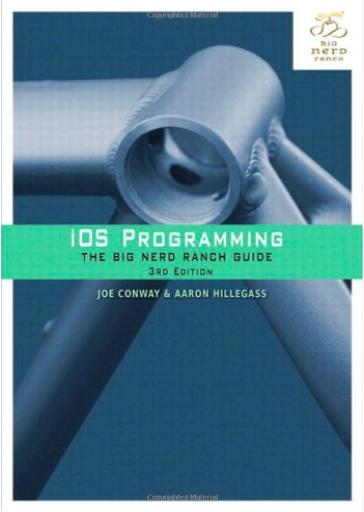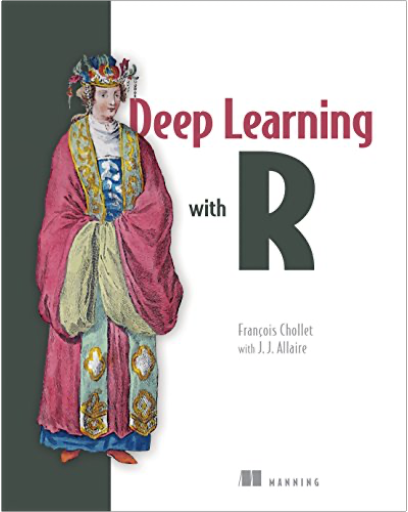 Deep Learning with RFrancois Chollet, J. J. Allaire Deep Learning with RFrancois Chollet, J. J. Allaire Summary
Deep Learning with R introduces the world of deep learning using the powerful Keras library and its R language interface. The book builds your understanding of deep learning through intuitive explanations and practical examples.
Purchase of the print book includes a free eBook in PDF, Kindle, and ePub formats from Manning Publications.
About the Technology
Machine learning has made remarkable progress in recent years. Deep-learning systems now enable previously impossible smart applications, revolutionizing image recognition and natural-language processing, and identifying complex patterns in data. The Keras deep-learning library provides data scientists and developers working in R a state-of-the-art toolset for tackling deep-learning tasks.
About the Book
Deep Learning with R introduces the world of deep learning using the powerful Keras library and its R language interface. Initially written for Python as Deep Learning with Python by Keras creator and Google AI researcher François Chollet and adapted for R by RStudio founder J. J. Allaire, this book builds your understanding of deep learning through intuitive explanations and practical examples. You'll practice your new skills with R-based applications in computer vision, natural-language processing, and generative models.
What's Inside
Deep learning from first principlesSetting up your own deep-learning environmentImage classification and generationDeep learning for text and sequences
About the Reader
You'll need intermediate R programming skills. No previous experience with machine learning or deep learning is assumed.
About the Authors
François Chollet is a deep-learning researcher at Google and the author of the Keras library.
J.J. Allaire is the founder of RStudio and the author of the R interfaces to TensorFlow and Keras.
Table of Contents
PART 1 - FUNDAMENTALS OF DEEP LEARNING What is deep learning?Before we begin: the mathematical building blocks of neural networksGetting started with neural networksFundamentals of machine learningPART 2 - DEEP LEARNING IN PRACTICE Deep learning for computer visionDeep learning for text and sequencesAdvanced deep-learning best practicesGenerative deep learningConclusions 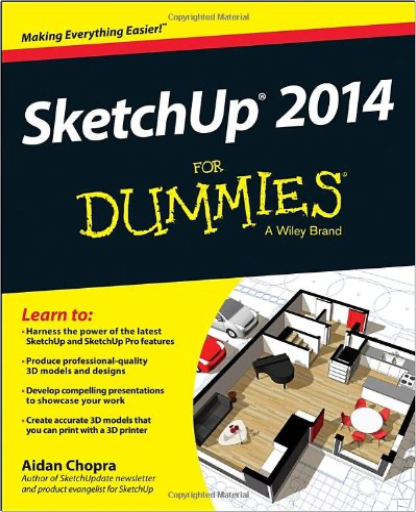 SketchUp 2014 For DummiesAidan Chopra SketchUp 2014 For DummiesAidan Chopra Start building your 3D model today with a comprehensive guide to SketchUp 2014
SketchUp 2014 For Dummies is a user-friendly guide to creating 3D models, adding textures, creating animated walkthroughs, and more, using one of the most popular 3D modeling programs on the market. Fully updated to align with the release of SketchUp, the book guides you through the interface, tools, techniques, and tricks in SketchUp and SketchUp Pro, on both Windows and Mac platforms. Written for designers with no prior 3D modeling experience, the book provides beginner- to intermediate-level instruction in this powerful program.
With a strong emphasis on usability rather than features, SketchUp has found widespread success around the world. Available as a free download, the program allows you to get comfortable and develop your skills before investing in the Pro version's additional features. SketchUp 2014 For Dummies gets you up to speed fast, beginning with an overview of the basic concepts of 3D modeling before getting down to business with the software. Organized for easy navigation, the book can also serve as a handy desk reference for more experienced designers getting acquainted with the latest update. Topics include: Using SketchUp 2014 to create 3D modelsPrinting on a plotter or 3D printerSharing designs via SketchUp 3D WarehouseExporting to another design package
The book also walks you through the creation of a detailed set of plans, and demonstrates how to give virtual "tours" of your design. A 16-page color insert illustrates the possibilities, and may just trigger your inspiration. Whether you're a designer, architect, engineer, or hobbyist, SketchUp 2014 For Dummies gets you started quickly. 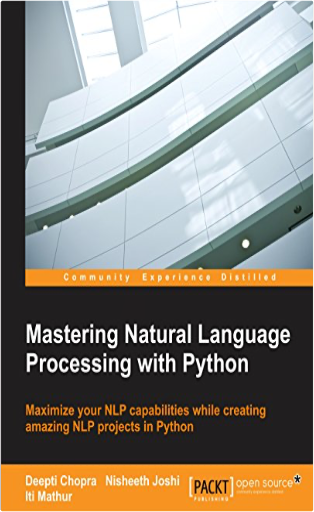 Mastering Natural Language Processing with PythonDeepti Chopra, Nisheeth Joshi, Iti Mathur Mastering Natural Language Processing with PythonDeepti Chopra, Nisheeth Joshi, Iti Mathur Maximize your NLP capabilities while creating amazing NLP projects in PythonAbout This Book Learn to implement various NLP tasks in PythonGain insights into the current and budding research topics of NLPThis is a comprehensive step-by-step guide to help students and researchers create their own projects based on real-life applicationsWho This Book Is For
This book is for intermediate level developers in NLP with a reasonable knowledge level and understanding of Python. What You Will Learn Implement string matching algorithms and normalization techniquesImplement statistical language modeling techniquesGet an insight into developing a stemmer, lemmatizer, morphological analyzer, and morphological generatorDevelop a search engine and implement POS tagging concepts and statistical modeling concepts involving the n gram approachFamiliarize yourself with concepts such as the Treebank construct, CFG construction, the CYK Chart Parsing algorithm, and the Earley Chart Parsing algorithmDevelop an NER-based system and understand and apply the concepts of sentiment analysisUnderstand and implement the concepts of Information Retrieval and text summarizationDevelop a Discourse Analysis System and Anaphora Resolution based systemIn Detail
Natural Language Processing is one of the fields of computational linguistics and artificial intelligence that is concerned with human-computer interaction. It provides a seamless interaction between computers and human beings and gives computers the ability to understand human speech with the help of machine learning.
This book will give you expertise on how to employ various NLP tasks in Python, giving you an insight into the best practices when designing and building NLP-based applications using Python. It will help you become an expert in no time and assist you in creating your own NLP projects using NLTK.
You will sequentially be guided through applying machine learning tools to develop various models. We’ll give you clarity on how to create training data and how to implement major NLP applications such as Named Entity Recognition, Question Answering System, Discourse Analysis, Transliteration, Word Sense disambiguation, Information Retrieval, Sentiment Analysis, Text Summarization, and Anaphora Resolution.  Fusion 360 für Maker: Modelle für 3D-Druck und CNC entwerfenLydia Sloan Cline Fusion 360 für Maker: Modelle für 3D-Druck und CNC entwerfenLydia Sloan Cline Verwandle deine am Bildschirm entworfenen dreidimensionalen Entwürfe in Objekte zum Anfassen. Autodesk Fusion 360 ist das richtige Werkzeug, um deine Ideen mit dem 3D-Drucker oder einer CNC-Fräse zu verwirklichen. Die Software ist für Studenten und für kleine Unternehmen kostenfrei verfügbar.
Das Buch zeigt dir anschaulich und mit vielen Screenshots, wie du mit Fusion 360 einfache und komplexe 3D-Modelle realisieren kannst. Du lernst dabei, massive, hohle, natürlich-organische oder auch parametrisch modellierte Strukturen zu erzeugen.
"Fusion 360 für Maker" richtet sich an alle, die die Software kennen lernen wollen. Das Buch wird dich in kurzer Zeit in die Lage versetzen, eigene Modelle für den 3D-Druck und die CNC-Fräse zu entwickeln.
Mit acht Einsteigertutorials lernst du die Grundlagen von Fusion 360 kennen. Du erfährst Schritt für Schritt im Verlauf zahlreicher Do-it-yourself-Projekte, wie du eigene Ideen umsetzen kannst. Die Projekte sind unter realen Bedingungen getestet. Sie behandeln auch häufig auftretende Probleme und liefern die Lösungen dazu. Jedes Projekt steht für sich alleine, sodass du direkt mit denen einsteigen kannst, die dich am meisten interessieren. 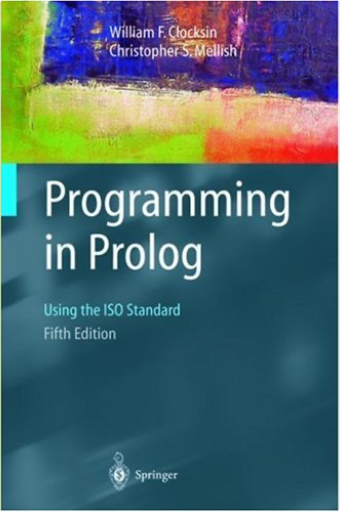 Programming in Prolog: Using the ISO StandardW.F. Clocksin, C.S. Mellish Programming in Prolog: Using the ISO StandardW.F. Clocksin, C.S. Mellish 4.5 Originally published in 1981, this was the first textbook on programming in the Prolog language and is still the definitive introductory text on Prolog. Though many Prolog textbooks have been published since, this one has withstood the test of time because of its comprehensiveness, tutorial approach, and emphasis on general programming applications.
Prolog has continued to attract a great deal of interest in the computer science community, and has turned out to be a basis for an important new generation of programming languages and systems for Artificial Intelligence. Since the previous edition of Programming in Prolog, the language has been standardised by the International Organization for Standardization (ISO) and this book has been updated accordingly. The authors have also introduced some new material, clarified some explanations, corrected a number of minor errors, and removed appendices about Prolog systems that are now obsolete. 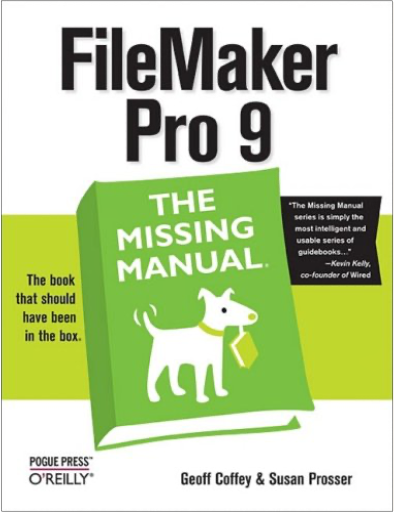 FileMaker Pro 9: The Missing ManualGeoff Coffey, Susan Prosser FileMaker Pro 9: The Missing ManualGeoff Coffey, Susan Prosser 4.5 FileMaker Pro 9: The Missing Manual is the clear, thorough and accessible guide to the latest version of this popular desktop database program. FileMaker Pro lets you do almost anything with the information you give it. You can print corporate reports, plan your retirement, or run a small country — if you know what you're doing. This book helps non-technical folks like you get in, get your database built, and get the results you need. Pronto.
The new edition gives novices and experienced users the scoop on versions 8.5 and 9. It offers complete coverage of timesaving new features such as the Quick Start screen that lets you open or a create a database in a snap, the handy "save to" buttons for making Excel documents or PDFs, the multiple level Undo and Redo commands let you step backwards through your typing tasks, and much more. With FileMaker Pro 9: The Missing Manual, you can:Get your first database running in minutes and perform basic tasks right away.Catalog people, processes and things with streamlined data entry and sorting tools.Learn to use layout tools to organize the appearance of your database.Use your data to generate reports, correspondence and other documents with ease.Create, connect, and manage multiple tables and set up complex relationships that show you just the data you need.Crunch numbers, search text, or pin down dates and times with dozens of built-in formulas.Automate repetitive tasks with FileMaker Pro 9's easy-to-learn scripting language.Protect your database with passwords and set up privileges to determine what others can do once they gain entry.Outfit your database for the Web and import and export data to other formats.Each chapter in the book contains "living examples" — downloadable tutorials that help you learn how to build a database by actually doing it. You also get plenty of sound, objective advice that lets you know which features are really useful, and which ones you'll barely touch. To make the most of FileMaker Pro 9, you need the book that should have been in the box. 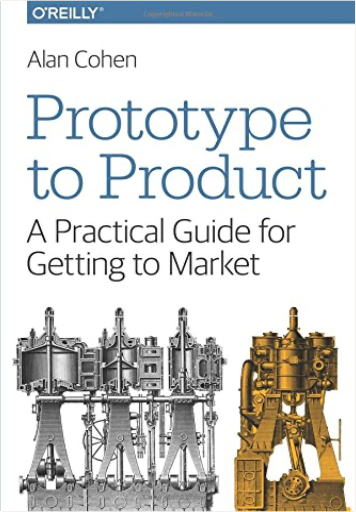 Prototype to Product: A Practical Guide for Getting to MarketAlan Cohen Prototype to Product: A Practical Guide for Getting to MarketAlan Cohen Product development is the magic that turns circuitry, software, and materials into a product, but moving efficiently from concept to manufactured product is a complex process with many potential pitfalls. This practical guide pulls back the curtain to reveal what happens—or should happen—when you take a product from prototype to production.
For makers looking to go pro or product development team members keen to understand the process, author Alan Cohen tracks the development of an intelligent electronic device to explain the strategies and tactics necessary to transform an abstract idea into a successful product that people want to use. Learn 11 deadly sins that kill product development projectsGet an overview of how electronic products are manufacturedDetermine whether your idea has a good chance of being profitableNarrow down the product’s functionality and associated costsGenerate requirements that describe the final product’s detailsSelect your processor, operating system, and power sourcesLearn how to comply with safety regulations and standardsDive into development—from rapid prototyping to manufacturing
Alan Cohen, a veteran systems and software engineering manager and lifelong technophile, specializes in leading the development of medical devices and other high-reliability products. His passion is to work with engineers and other stakeholders to forge innovative technologies into successful products. 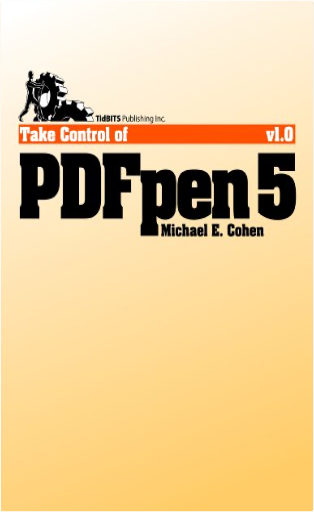 Take Control of PDFpen 5Michael E Cohen Take Control of PDFpen 5Michael E Cohen After a whirlwind history and overview of PDF, you'll take a tour through PDFpen's tools and navigation. With those basics taken care of, you'll learn how to:
Scan a document to PDF and make the text editable with OCR
Combine pages from multiple files into a single PDF
Turn a Web site into a multi-page PDF
Add or remove pages from a PDF
Add a hand-written signature to a PDF
Add page and URL links to a PDF
Make a clickable table of contents for a PDF
Use professional editing marks on a PDF
Edit text within a PDF that was received in email
Leave comments on a PDF document
Remove sensitive or confidential text from a PDF
Enhance the images in a PDF
Fill out a PDF-based form
Print just form entries on a pre-printed form
Create an interactive PDF-based form that can collect data and send it to you via email or the Web
An appendix describes the many useful AppleScripts that ship with PDFpen.
This ebook was created in collaboration with Smile, with Michael providing feedback during the PDFpen 5 development process and PDFpen's developers tech editing the book for complete accuracy. 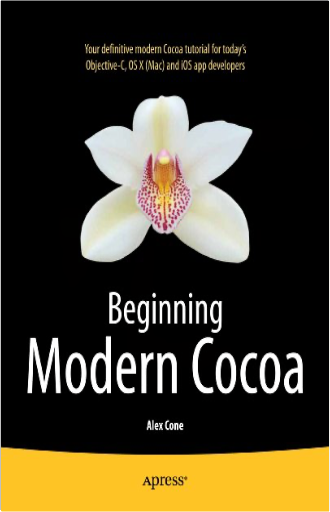 Beginning Modern CocoaAlex Cone Beginning Modern CocoaAlex Cone Beginning Modern Cocoa is a modern or Apps era Cocoa programming guide that introduces you to the world of Mac OS X app programming as Apple redefines the platform to its core. New technologies from the iOS platform are being integrated into OS X. OS X is evolving rapidly and contributing technologies back to iOS.
Even venerable Objective-C has been overhauled and enhanced. The core toolset has been radically rethought into Xcode 4, which now integrates everything into one consistent environment designed to maximize developer productivity. So, this modern Cocoa tutorial incorporates Objective-C changes and keeps in mind today's modern apps-based approach.
With this definitive tutorial by Alex Cone, one of the founders of Cocoa and Cocoa touch, start developing with the latest tools like Cocoa Auto Layout UI, Blocks, Mac App Store Deployment and Push Notifications.
Learn how to seamlessly integrate iCloud support so your app seems to magically have its data wherever you are. Most chapters in this action packed tutorial come with examples and use case scenarios that you can learn from and apply to your own situations.
What you’ll learn What is Cocoa and Cocoa touchWhat are some Objective-C fundamentals that may be needed, if you're newWhat are today's best and most useful Cocoa design patternsHow to work with events, Core Data, iCloud, files, i/o, etc.What are and how to use the Cocoa User Experience and Interface APIsHow to do fancy text and employ animation with Core AnimationHow to use this book's many examples and apply to your own situationsWho this book is for
This book is for new and experienced Objective-C programmers looking to learn the most popular Objective-C framework and libraries, called Cocoa. It's also for Mac and even iOS app developers looking to refine their Objective-C and Cocoa skills, techniques and use.  CUDA Programming: A Developer's Guide to Parallel Computing with GPUsShane Cook CUDA Programming: A Developer's Guide to Parallel Computing with GPUsShane Cook If you need to learn CUDA but don't have experience with parallel computing, CUDA Programming: A Developer's Introduction offers a detailed guide to CUDA with a grounding in parallel fundamentals. It starts by introducing CUDA and bringing you up to speed on GPU parallelism and hardware, then delving into CUDA installation. Chapters on core concepts including threads, blocks, grids, and memory focus on both parallel and CUDA-specific issues. Later, the book demonstrates CUDA in practice for optimizing applications, adjusting to new hardware, and solving common problems.
Comprehensive introduction to parallel programming with CUDA, for readers new to bothDetailed instructions help readers optimize the CUDA software development kitPractical techniques illustrate working with memory, threads, algorithms, resources, and moreCovers CUDA on multiple hardware platforms: Mac, Linux and Windows with several NVIDIA chipsetsEach chapter includes exercises to test reader knowledge |
 Deep Learning with RFrancois Chollet, J. J. Allaire
Deep Learning with RFrancois Chollet, J. J. Allaire  SketchUp 2014 For DummiesAidan Chopra
SketchUp 2014 For DummiesAidan Chopra  Mastering Natural Language Processing with PythonDeepti Chopra, Nisheeth Joshi, Iti Mathur
Mastering Natural Language Processing with PythonDeepti Chopra, Nisheeth Joshi, Iti Mathur  Fusion 360 für Maker: Modelle für 3D-Druck und CNC entwerfenLydia Sloan Cline
Fusion 360 für Maker: Modelle für 3D-Druck und CNC entwerfenLydia Sloan Cline  Programming in Prolog: Using the ISO StandardW.F. Clocksin, C.S. Mellish
Programming in Prolog: Using the ISO StandardW.F. Clocksin, C.S. Mellish  FileMaker Pro 9: The Missing ManualGeoff Coffey, Susan Prosser
FileMaker Pro 9: The Missing ManualGeoff Coffey, Susan Prosser  Prototype to Product: A Practical Guide for Getting to MarketAlan Cohen
Prototype to Product: A Practical Guide for Getting to MarketAlan Cohen  Take Control of PDFpen 5Michael E Cohen
Take Control of PDFpen 5Michael E Cohen  Beginning Modern CocoaAlex Cone
Beginning Modern CocoaAlex Cone  CUDA Programming: A Developer's Guide to Parallel Computing with GPUsShane Cook
CUDA Programming: A Developer's Guide to Parallel Computing with GPUsShane Cook  Made with Delicious Library
Made with Delicious Library

